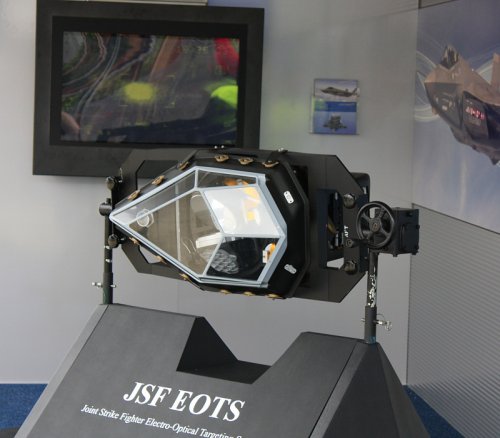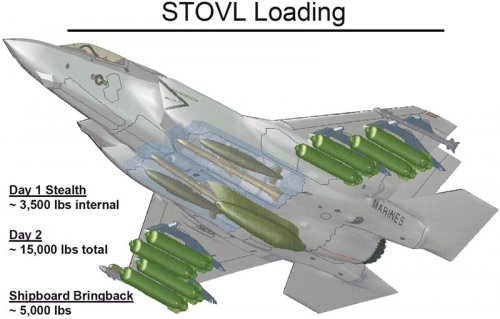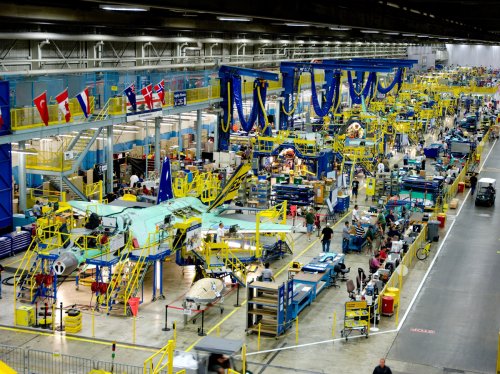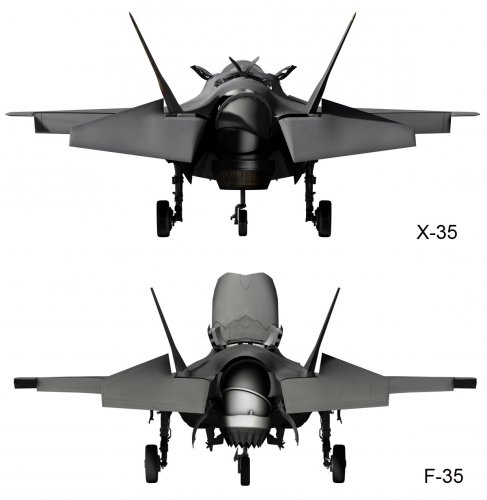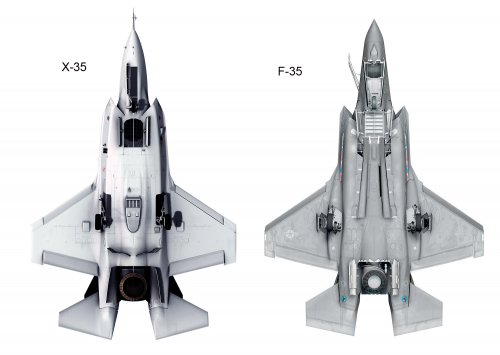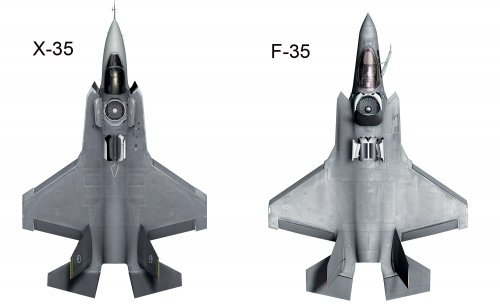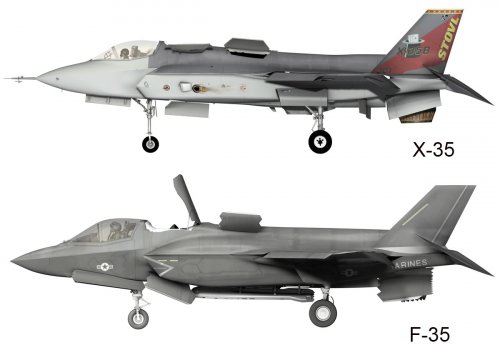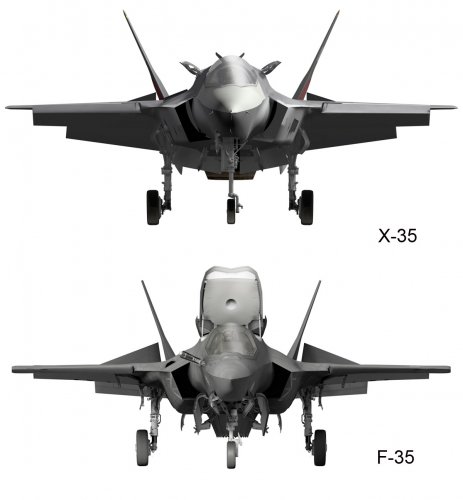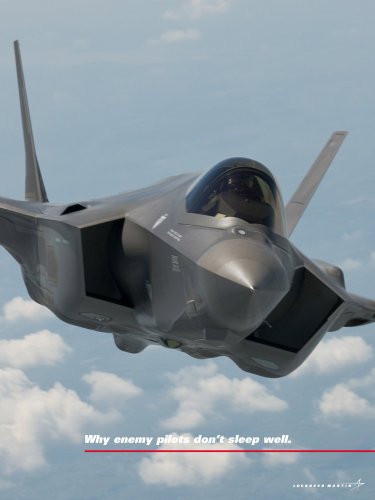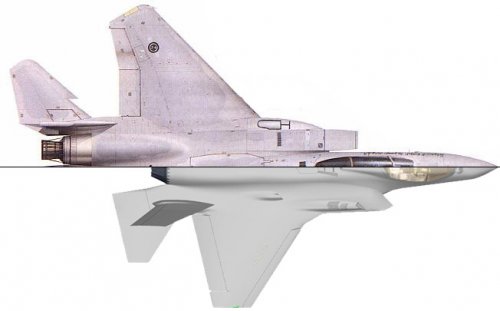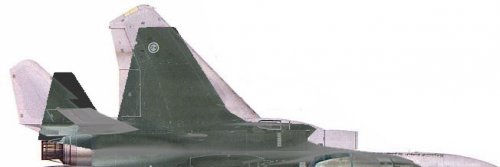You are using an out of date browser. It may not display this or other websites correctly.
You should upgrade or use an alternative browser.
You should upgrade or use an alternative browser.
The F-35 No Holds Barred topic
- Thread starter overscan (PaulMM)
- Start date
saintkatanalegacy
Little Miss Whiffologist
- Joined
- 31 March 2009
- Messages
- 718
- Reaction score
- 9
kinda odd that it looks asymmetric at that view
is it possible though for a frameless EOTS to be in development?
is it possible though for a frameless EOTS to be in development?
S
sublight
Guest
I haven't seen any posts on this. This would certainly address the "delicate high maintenance stealth coating" fears....
http://www.aviationweek.com/aw/generic/story_channel.jsp?channel=defense&id=news/asd/2010/05/17/10.xml
http://www.aviationweek.com/aw/generic/story_channel.jsp?channel=defense&id=news/asd/2010/05/17/10.xml
saintkatanalegacy
Little Miss Whiffologist
- Joined
- 31 March 2009
- Messages
- 718
- Reaction score
- 9
^so that also means less nuts and bolts on the exterior?
- Joined
- 2 August 2006
- Messages
- 3,175
- Reaction score
- 1,159
saintkatanalegacy said:^so that also means less nuts and bolts on the exterior?
I think it means you don't have to worry about tiny dings and chips effecting the LO that much, like you would have to if it's LO rating relied on the coatings so much.
saintkatanalegacy
Little Miss Whiffologist
- Joined
- 31 March 2009
- Messages
- 718
- Reaction score
- 9
well, if you have to rely less(or even barely) on RAM paint the panels would have to be glued since having nuts and bolts externally would also require painting. that's basically what i meant
- Joined
- 2 August 2006
- Messages
- 3,175
- Reaction score
- 1,159
I see what you're saying. I think they still use some sort of putty, or whatever, where the fasteners are and they obviously have to fill the gaps between panels, but it still seems it's an order of magnitude less in maintenance in just requiring the "paint" coating as opposed to a metallic LO coating to maintain the signature.
Canada’s Next Generation Fighter Capability – The Joint Strike Fighter F-35 Lightning II
BG–10.018 - July 16, 2010
The Canada First Defence Strategy states that the Canadian Forces will acquire a next-generation fighter capability that will help them carry out their core missions of defending the sovereignty of Canadian and North American airspace through the North American Aerospace Defense Command (NORAD), and providing Canada with an effective and modern capability for international operations.
Canada will acquire an aircraft fully interoperable with our key allies to effectively conduct joint operations through the North Atlantic Treaty Organization (NATO) or a coalition. At home, the Canadian Forces will acquire a robust aircraft, capable of operating across Canada’s vast geography and under harsh and varying weather conditions. A next generation fighter with stealth technology is an extremely effective deterrent against challenges to Canadian sovereignty.
In July 2010, the Government of Canada announced it is acquiring the Joint Strike Fighter (JSF) F-35, a fifth generation fighter jet, to replace its fourth generation fleet of CF-18s, which are expected to reach the end of their operational life in the 2017-2020 timeframe. Delivery of the new aircraft is expected to start in 2016.
The F-35 is the only available fifth generation aircraft that meets the Canadian Forces’s need for a next-generation fighter. The acquisition of the F-35 will help the Canadian Forces operate effectively to defend against the threats of the 21st century at home and abroad.
The F-35 is less visible to radar, providing very low observable stealth, has integrated sensor fusion that provides the pilot with all available information at a glance, and high-capacity, secure net-enabled operations that allows all F-35 aircraft to communicate with each other and share data in a secure environment.
What constitutes a fifth generation fighter?
There are three key capabilities that distinguish a fifth generation fighter aircraft from a fourth generation:
1. Interoperability: a fifth generation aircraft provides a unique combination of stealth, long-range high-resolution sensors, and secure high-capacity networks that allow all F-35 aircraft to communicate with each other and share data in a secure environment;
2. Sensors/Data fusion: fifth generation incorporates a system that consolidates tactical information from the sensors and off-board sources to provide pilots with a clear understanding of the tactical situation at a glance;
3. Survivability: the survivability of a fifth generation aircraft is significantly increased by very low observable stealth, advanced sensors and secure data-link, which means a fifth generation aircraft can accomplish more in a mission with fewer supporting assets required.
A fourth generation aircraft cannot be upgraded to a fifth generation; the capabilities of a fifth generation aircraft, such as stealth technology, long-range high-resolution sensors, automated data fusion and secure high-capacity networks, must be built in.
A fifth generation fighter provides Canada with the highest probability of mission success, as well as the highest probability that the Canadian Forces pilot and aircraft will return home safely from the mission.
The Joint Strike Fighter Program and Canada’s History of Participation
The F-35 has been developed by Lockheed Martin and partners through the Joint Strike Fighter (JSF) program, a multinational effort to build and sustain an affordable, multi-role, next generation stealth fighter aircraft. Partners in the program include: the United States, Canada, the United Kingdom, the Netherlands, Italy, Turkey, Denmark, Norway, and Australia. Purchasing the F-35 will ensure Canada remains interoperable with these major allies – including the US, our NORAD partner – well into the middle of this century.
JSF is the single largest fighter aircraft program in history. The total value of the program is expected to exceed US$383 billion, with production expected to top 5,000 aircraft; JSF partners are anticipated to acquire more than 3,000 aircraft, and export sales are estimated by Lockheed Martin at more than 2,000 aircraft. Based on these predictions, royalties from the export sales amounting to approximately $130 million will accrue to the Government of Canada’s Consolidated Revenue Fund.
The JSF program is comprised of three distinct phases: the Concept Demonstration Phase (1997 – 2001) which involved two competing bidders developing prototype aircraft (Lockheed Martin was selected as the prime contractor); the System Development and Demonstration Phase (2001 – 2013), developing and testing the aircraft systems and components to be used; and finally, the Production, Sustainment and Follow-on Development Phase (2007-2051), initiating production of the aircraft and sustaining parts for the serviceable life of the aircraft and follow-on development.
Canada has been a participant in the JSF program since 1997, when the Department of National Defence signed on to the Concept Demonstration phase with an investment of US$10 million. As part of this phase, Canada participated in the extensive and rigorous U.S.-led competitive process where two bidders, Boeing and Lockheed Martin, developed and competed prototype aircraft. This process led to the selection of Lockheed Martin as the JSF manufacturer in 2001.
In 2002, Canada joined the System Development and Demonstration phase with a monetary investment of U.S.$100 million, with an additional U.S.$50 million contributed through federal Canadian technology investment programs. The System Development and Demonstration phase runs through 2015.
In 2003, the United States invited the current partners to participate in the Production, Sustainment and Follow-on Development phase of the program. In December 2006, Canada signed the JSF Production, Sustainment and Follow-on Development Memorandum of Understanding (MOU). The cost for Canada to participate in this phase is approximately U.S.$551 million over the course of the 2007-2051 timeframe. This contribution will be used to cover Canada’s portion of production, sustainment and follow-on development costs, including common tooling, sustainment, and follow-on development activities.
Acquiring a Next Generation Fighter Capability
In 2008, the Government of Canada announced its intent to replace the CF-18 fleet with a Next Generation Fighter Capability (NGFC). This was announced as a key commitment under the Canada First Defence Strategy.
In 2010, the Government of Canada exercised its options under the JSF program memorandum of understanding with the partner nations to acquire the F-35 to meet Canada’s operational requirement, while providing the best value for Canada.
By acquiring a next generation fighter aircraft through the JSF program, Canada will see a significant reduction in the cost of acquisition and savings throughout the life-cycle of the aircraft, due to the collaborative approach to the sustainment and follow-on development.
The Government of Canada has committed approximately CAD$9 billion to the acquisition of 65 F-35 aircraft and associated weapons, supporting infrastructure, initial spares, training simulators, contingency funds and project operating costs. This is funded through the Canada First Defence Strategy and the National Defence Investment Plan.
The majority of the expenditures will not be required until the 2015-2020 timeframe, when Canada will begin to take delivery of the aircraft. Canadian industry will begin to benefit immediately, providing a near-term boost to the Canadian aerospace and defence sector.
Sustained Economic Benefits for Canadian Industry
Canada’s participation in the JSF program brings significant benefits to Canada. This program is delivering on the Canada First Defence Strategy’s commitment to a renewed relationship with Canada’s defence industry, leveraging Canada’s competitive advantage and working with industry to help position Canadian companies for success in the global marketplace. With a long-term investment in this aircraft, Canada’s defence industry has a rare and unique opportunity to be a part of the JSF global supply chain, advancing its technology, while bringing jobs and sustained economic benefits to regions across Canada.
In order to maximize industrial benefits and minimize costs, partner countries agreed to a best-value approach to industrial participation in the JSF program. In accordance with the JSF memorandum of understanding and in support of Canadian industry, Industry Canada has signed agreements with Lockheed Martin and partners. These industrial participation agreements have provided unprecedented access to a significant multinational defence program for companies across Canada, including small and medium enterprises.
Participation in the JSF program has already provided Canadian industry with long-term, high technology industrial opportunities, such as advanced composite manufacturing, mission systems and high speed machining. To date, Canada has invested approximately CAD$168 million in the JSF program. Since 2002, the Government’s participation in the JSF program has led to more than CAD$350 million in contracts for more than 85 Canadian companies, research laboratories, and universities—meaning that Canada has already seen a two-to-one return on its investment.
Now that Canada has committed to purchasing the F-35, Canadian industrial opportunities could exceed CAD$12 billion for the production of the aircraft. Sustainment and follow-on opportunities for Canadian industry are emerging and will be available over the 40-year life of the program. For instance, in accordance with the industrial participation agreements, all 19 Canadian companies manufacturing items for the F-35 will also repair and overhaul those components for the entire global fleet.
Conclusion
Not only does the F-35 meet all of the Canadian Forces operational requirements for a next generation fighter aircraft, the F-35 offers the best value by providing exceptional capability at the lowest cost with excellent benefits and opportunities for the Canadian defence industry. This acquisition will equip the Canadian Forces with the aircraft it needs to defend Canada’s sovereignty and contribute to the defence of North America and international security.
-30-
For more information: 1-866-377-0811/613-996-2353
www.forces.gc.ca
More info: http://www.forces.gc.ca/site/pri/2/pro-pro/ngfc-eng.asp
Regards,
Greg
Matej
Multiuniversal creator
- Joined
- 17 October 2006
- Messages
- 2,282
- Reaction score
- 607
Awesome.
I should imagine that a configuration like that would be at bingo fuel by the time it got the landing gear up.
I should imagine that a configuration like that would be at bingo fuel by the time it got the landing gear up.
- Joined
- 1 April 2006
- Messages
- 10,730
- Reaction score
- 6,760
LO, glad to see you back!
Thirty-one F-35s are in various stages of assembly as of July 2010. The last test jet, BF-5, recently was delivered from the factory. The first production jet, AF-6, is in final assembly and will roll out in the summer of 2010. The maximum production rate will be about one aircraft per working day, a level that will be reached in 2016.
Photo by Fred Clingerman
Thirty-one F-35s are in various stages of assembly as of July 2010. The last test jet, BF-5, recently was delivered from the factory. The first production jet, AF-6, is in final assembly and will roll out in the summer of 2010. The maximum production rate will be about one aircraft per working day, a level that will be reached in 2016.
Photo by Fred Clingerman
Attachments
Colonial-Marine
UAVs are now friend, drones are the real enemy.
- Joined
- 5 October 2009
- Messages
- 1,197
- Reaction score
- 709
LowObservable said:Awesome.
I should imagine that a configuration like that would be at bingo fuel by the time it got the landing gear up.
What makes you say that? The STOVL version still has over 13,000 pounds of fuel to work with.
Side-by-side illustrations comparing X-35 to production F-35.
Source: http://www.codeonemagazine.com/article.html?item_id=28
Source: http://www.codeonemagazine.com/article.html?item_id=28
Attachments
- Joined
- 18 March 2008
- Messages
- 3,532
- Reaction score
- 724
Colonial-Marine said:What makes you say that?
It's his calling in life, apparantly...
Colonial-Marine said:The STOVL version still has over 13,000 pounds of fuel to work with.
And its a "STOVL" configuration so takeoff has the benefit of a run up and/or ski jump and presumably its not a take back load (it looks like an amphibious assault anti beach/surf zone mine clearing load) so all those CBUs will be gone by the time it needs to hover.
Colonial-Marine
UAVs are now friend, drones are the real enemy.
- Joined
- 5 October 2009
- Messages
- 1,197
- Reaction score
- 709
Abraham Gubler said:And its a "STOVL" configuration so takeoff has the benefit of a run up and/or ski jump and presumably its not a take back load (it looks like an amphibious assault anti beach/surf zone mine clearing load) so all those CBUs will be gone by the time it needs to hover.
Capable of bringing back 5000 lb of ordinance according to that diagram. I don't know how the Harrier II compares here, but I doubt it is vastly superior in any regard to the F-35B.
- Joined
- 2 January 2006
- Messages
- 656
- Reaction score
- 236
Whats the bring back limit in STOL mode ?, as thats how the Royal navy would prefer to use them rather in pure STOVL mode from the CVF (wober if they have thought about a crash barrier on the axial flight deck as any space reserved in the design would have been orientated for the Angled deck ? :-\)
- Joined
- 3 June 2011
- Messages
- 17,332
- Reaction score
- 9,070
According to the picture on the previous page it's 5,000lbs. Whether that means 5,000lbs of weapons in addition to whatever fuel is on board or 5,000lbs total between fuel and weapons though I don't know. Probably the latter.
- Joined
- 18 March 2008
- Messages
- 3,532
- Reaction score
- 724
Colonial-Marine said:Capable of bringing back 5000 lb of ordinance according to that diagram. I don't know how the Harrier II compares here, but I doubt it is vastly superior in any regard to the F-35B.
I doubt the Harrier II can even takeoff (STOL) with 5,000 lbs not to mention hover with it. But that weapons load in the picture is going to weigh more than 5,000 lbs however that kind of mission (amphibious assault support) involves dropping bombs not on a target but on a grid square to cover the entire beach/surf zone that the amphibians and landing craft are going to cross so all the mines and bunkers are destroyed and suppressed (USN used to have BBs, CAs and LFS to do that mission). So it’s not a ROE/target solution dependent mission. The only way you are not going to be dropping the bombs is if you have some kind of aircraft malfunction in which case the payload would all be jettisoned anyway. So bring back is not an issue.
sferrin said:According to the picture on the previous page it's 5,000lbs. Whether that means 5,000lbs of weapons in addition to whatever fuel is on board or 5,000lbs total between fuel and weapons though I don't know. Probably the latter.
I should know the answer to that question and I probably have it in notes somewhere. When you fly the F-35 ‘computer game for VIPs’ aka ‘simulator’ one of the first things you do is play with the hover features. Because you usually start in mid air with full fuel and weapons as soon as you press the hover mode button (and that’s all you have to do) the aircraft automatically starts dumping fuel to get down to the hover weight. So its not 5,000 lbs of payload plus 13,000 lbs of fuel. But there will be a significant fuel margin to allow for a couple of approaches as well as a typical payload (5,000 lbs). But since the F-35B is so much better at hovering than the Harrier and the deck tolerances (pitch) for VTOL operations are so much higher this should not be a major issue.
- Joined
- 17 October 2006
- Messages
- 2,282
- Reaction score
- 607
CM - 13000 pounds of fuel translates into a very average clean fuel fraction for the B model - 0.29, which is about the same or less than most of today's fighters, and there's a reason you don't see them with 12000+ pounds of high-drag ordnance and no drop tanks.
The KPP bring-back load is 2 x 1000 pound JDAMs and two AMRAAMs, or just under 3000 lb, so I suspect that the 5000 pound figure includes fuel.
The KPP bring-back load is 2 x 1000 pound JDAMs and two AMRAAMs, or just under 3000 lb, so I suspect that the 5000 pound figure includes fuel.
Colonial-Marine
UAVs are now friend, drones are the real enemy.
- Joined
- 5 October 2009
- Messages
- 1,197
- Reaction score
- 709
I have read figures for the F-35B ranging from 13,325 lb to 14,000 lbs. Can anybody confirm what it actually is? Either way, carrying about as much internal fuel as a F-15A is pretty impressive for a true STOVL aircraft in my opinion, especially when you consider the lack of success in the field with the exception of the aging Harrier.
saintkatanalegacy
Little Miss Whiffologist
- Joined
- 31 March 2009
- Messages
- 718
- Reaction score
- 9
I'm glad people aren't bickering on recent topics similar to the key forums... phew
- Joined
- 17 October 2006
- Messages
- 2,282
- Reaction score
- 607
Again, CM, the key number for range is the fuel fraction - (Internal Fuel)/(OEW + Fuel + Pilot/Fluids).
And the fact that the F-35B carries as much internal fuel as an F-15A would be more impressive were it not for the fact that the jet's empty weight is two tons more than an F-15A.
The intent from the earliest days of the fan-augmented concepts (1991-92) was that the STOVL version would have a fuel fraction on a par with conventional fighters while the CV and CTOL versions would use the fan system volume for fuel.
And the fact that the F-35B carries as much internal fuel as an F-15A would be more impressive were it not for the fact that the jet's empty weight is two tons more than an F-15A.
The intent from the earliest days of the fan-augmented concepts (1991-92) was that the STOVL version would have a fuel fraction on a par with conventional fighters while the CV and CTOL versions would use the fan system volume for fuel.
Colonial-Marine
UAVs are now friend, drones are the real enemy.
- Joined
- 5 October 2009
- Messages
- 1,197
- Reaction score
- 709
LowObservable said:Again, CM, the key number for range is the fuel fraction - (Internal Fuel)/(OEW + Fuel + Pilot/Fluids).
And the fact that the F-35B carries as much internal fuel as an F-15A would be more impressive were it not for the fact that the jet's empty weight is two tons more than an F-15A.
The intent from the earliest days of the fan-augmented concepts (1991-92) was that the STOVL version would have a fuel fraction on a par with conventional fighters while the CV and CTOL versions would use the fan system volume for fuel.
It looks like the weight has yet to be finalized for any of the F-35 variants, but only the highest estimates for the production F-35B's empty weight are 32,000 lbs. And I doubt one F135 is as fuel hungry as two F100s, even though it is a big engine. Seems like Lockheed achieved that aim even if it isn't on the same level as a F-22, Flanker, and the latest Eurocanards.
I have my concerns about the aircraft for sure, but range isn't one of them.
- Joined
- 3 June 2011
- Messages
- 17,332
- Reaction score
- 9,070
Colonial-Marine said:I have read figures for the F-35B ranging from 13,325 lb to 14,000 lbs. Can anybody confirm what it actually is? Either way, carrying about as much internal fuel as a F-15A is pretty impressive for a true STOVL aircraft in my opinion, especially when you consider the lack of success in the field with the exception of the aging Harrier.
It's got more than an F-15A and is closer to an F-15C. F-15A only had 12172 internal while the F-15C has 14076 (though I've seen 13,500 for the F-15C too. I'm assuming 6.8lbs./gallon fuel density.)
Attachments
- Joined
- 18 March 2008
- Messages
- 3,532
- Reaction score
- 724
Colonial-Marine said:And I doubt one F135 is as fuel hungry as two F100s, even though it is a big engine.
There is an extremely important third dimension in considering aircraft range other than fuel and fuel consumption. And that is aerodynamics. This determines how much thrust is needed to fly the aircraft at a certain speed. The amount of thrust needed determines the level of fuel consumption rather than some vague assumptioning about maximum installed thrust of the engine(s). The specific fuel consumption (how much fuel is needed per unit of thrust/time) of the F-35’s F135/F136 engine will be better than the F-15’s two F100/F110 but I doubt the F-35 will be competitive with the F-15 for drag. So the F-35 will need more thrust for the same speed.
- Joined
- 3 June 2011
- Messages
- 17,332
- Reaction score
- 9,070
Abraham Gubler said:Colonial-Marine said:And I doubt one F135 is as fuel hungry as two F100s, even though it is a big engine.
There is an extremely important third dimension in considering aircraft range other than fuel and fuel consumption. And that is aerodynamics. This determines how much thrust is needed to fly the aircraft at a certain speed. The amount of thrust needed determines the level of fuel consumption rather than some vague assumptioning about maximum installed thrust of the engine(s). The specific fuel consumption (how much fuel is needed per unit of thrust/time) of the F-35’s F135/F136 engine will be better than the F-15’s two F100/F110 but I doubt the F-35 will be competitive with the F-15 for drag. So the F-35 will need more thrust for the same speed.
Start putting weapons on it though. . . (also consider wet area and parasitic drag)
- Joined
- 18 March 2008
- Messages
- 3,532
- Reaction score
- 724
sferrin said:also consider wet area and parasitic drag
I think you will find that both of these come under the general heading of:
Abraham Gubler said:And that is aerodynamics.
- Joined
- 3 June 2011
- Messages
- 17,332
- Reaction score
- 9,070
Abraham Gubler said:sferrin said:also consider wet area and parasitic drag
I think you will find that both of these come under the general heading of:
Abraham Gubler said:And that is aerodynamics.
Yes, they do. I'd wondered if you took them into account when you said "I doubt the F-35 will be competitive with the F-15 for drag". It's hard to believe a larger aircraft with crap hanging all over it is going to have less drag than the smaller one carrying it's weapons internally.
- Joined
- 18 March 2008
- Messages
- 3,532
- Reaction score
- 724
sferrin said:It's hard to believe a larger aircraft with crap hanging all over it is going to have less drag than the smaller one carrying it's weapons internally.
Of course but that doesn't have much to do with a comparison between the F-35 and a F-15 carrying two 2,000 lbs bombs and two AMRAAMs.

- Joined
- 3 June 2011
- Messages
- 17,332
- Reaction score
- 9,070
saintkatanalegacy
Little Miss Whiffologist
- Joined
- 31 March 2009
- Messages
- 718
- Reaction score
- 9
well, the wing is transonic...
although the tail plane does have a drag reduction shaping...
can't tell which is draggier by the picture
although the tail plane does have a drag reduction shaping...
can't tell which is draggier by the picture
- Joined
- 18 March 2008
- Messages
- 3,532
- Reaction score
- 724
Comparing plan surface area is not the best way to estimate drag... The frontal area is at least a starting point. The F-35 won't be short legged but its no F-15. Of course the F-35 would beat an F-15 hands down in any engagement but they were designed for very different things. The F-15 for flying through the air as best as possible and the F-35 for seeing and not being seen as best as possible. Rather than trying to manufacture an argument based on a limited understanding of aircraft design to support the F-35 over the F-15 you should focus on the important inputs to overall capability.
- Joined
- 17 October 2006
- Messages
- 2,282
- Reaction score
- 607
AG - Of course your frontal area comparison shows conformal tanks on the F-15E, hence a different internal fuel fraction.
It also raises the interesting question of wingspan. Not only does the F-35A have 8 feet less span than the F-15, which is not exactly good for induced drag, but much of the total span is accounted for by the body, and classically body lift is less efficient than wing lift. At the best you're going to have a flat-top lift distribution with much of the lift out at the tips.
It also raises the interesting question of wingspan. Not only does the F-35A have 8 feet less span than the F-15, which is not exactly good for induced drag, but much of the total span is accounted for by the body, and classically body lift is less efficient than wing lift. At the best you're going to have a flat-top lift distribution with much of the lift out at the tips.
- Joined
- 2 August 2006
- Messages
- 3,175
- Reaction score
- 1,159
The simple facts are the F-15 was optimized for it's mission, just as the F-35 was optimized for it's mission. As I posted in key forums regarding the F-35 vs Typhoon debate, the F-15 can't perform the F-35's mission and the F-35 can't perform the F-15's mission; by design.
Also, when it comes to drag, there's boat tail drag, interference drag, trim drag, etc. Something also not being considered here, which is a mistake I see many make time and time again, is that the F-15 is a naturally stable aircraft, so it's wing is providing all of the lift. The F-35 is not, it's an unstable design and therefore, at least at subsonic speeds, it's tail contributes to lift as well, so just comparing the wings of the two vehicles isn't going to be enough of an aerodynamic analysis comparison regarding the performance of the two aircraft.
Although, I am thoroughly enjoying flying the F-35A in FSX. ;D


Also, when it comes to drag, there's boat tail drag, interference drag, trim drag, etc. Something also not being considered here, which is a mistake I see many make time and time again, is that the F-15 is a naturally stable aircraft, so it's wing is providing all of the lift. The F-35 is not, it's an unstable design and therefore, at least at subsonic speeds, it's tail contributes to lift as well, so just comparing the wings of the two vehicles isn't going to be enough of an aerodynamic analysis comparison regarding the performance of the two aircraft.
Although, I am thoroughly enjoying flying the F-35A in FSX. ;D


- Joined
- 18 March 2008
- Messages
- 3,532
- Reaction score
- 724
LowObservable said:AG - Of course your frontal area comparison shows conformal tanks on the F-15E, hence a different internal fuel fraction.
And a classic example of good aerodynamics. In subsonic flight those conformal packs reduce the F-15's drag. They only stack on drag at transonic and supersonic.
Colonial-Marine
UAVs are now friend, drones are the real enemy.
- Joined
- 5 October 2009
- Messages
- 1,197
- Reaction score
- 709
Abraham I understand the concept of SFC but I simply doubt that the F-15 has any significant advantage or disadvantage in terms of drag. In my opinion Lockheed proved with the F-22 that they could make a stealth aircraft without it being too "draggy". While the F-35 is much more of a strike aircraft, some of that experience carried over. And the F-35 is supposed to have a better acceleration rate than the F-16 with a similar T/W ratio.
saintkatanalegacy
Little Miss Whiffologist
- Joined
- 31 March 2009
- Messages
- 718
- Reaction score
- 9
CFD anyone? :-[

